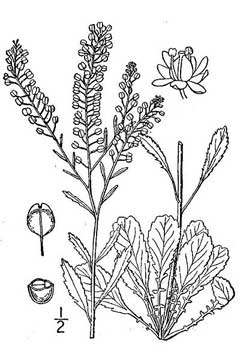 |
|
USDA-NRCS PLANTS Database / Britton, N.L., and A. Brown. 1913. Illustrated flora of the northern states and Canada. Vol. 2: 165. |
 |
| http://commons.wikimedia.org/wiki/User:Tau%CA%BBolunga |
Translate this page:
Summary
Physical Characteristics

 Lepidium virginicum is a ANNUAL/BIENNIAL growing to 0.5 m (1ft 8in). It is in flower from May to October. The species is hermaphrodite (has both male and female organs) and is pollinated by Insects.
Lepidium virginicum is a ANNUAL/BIENNIAL growing to 0.5 m (1ft 8in). It is in flower from May to October. The species is hermaphrodite (has both male and female organs) and is pollinated by Insects.
Suitable for: light (sandy), medium (loamy) and heavy (clay) soils. Suitable pH: mildly acid, neutral and basic (mildly alkaline) soils. It can grow in semi-shade (light woodland) or no shade. It prefers moist soil.
UK Hardiness Map
US Hardiness Map
Synonyms
L. intermedium.
Plant Habitats
Cultivated Beds;
Edible Uses
Edible Parts: Leaves Seedpod
Edible Uses: Condiment
Young leaves - raw or cooked[55, 62, 159]. The leaves are a rich source of vitamin C[254] and have a hot cress-like flavour[144]. Chopped finely and added to salads, used as a garnish or cooked as greens[183]. Unripe seedpods have a pleasantly pungent flavour and can be eaten raw[55] or used as a condiment in soups and stews[183]. The seed is a pepper substitute[62, 159].
References More on Edible Uses
Medicinal Uses
Plants For A Future can not take any responsibility for any adverse effects from the use of plants. Always seek advice from a professional before using a plant medicinally.
Anthelmintic Antiasthmatic Antiscorbutic Antitussive Cardiotonic Diuretic Vitamin C
The leaves of wild pepper-grass are nutritious and generally detoxifying, they have been used to treat vitamin C deficiency and diabetes, and to expel intestinal worms[254]. The herb is also diuretic and of benefit in easing rheumatic pain[254]. North American Indians used the bruised fresh plant, or a tea made from the leaves to treat poison ivy rash and scurvy[222]. A poultice of the leaves was applied to the chest in the treatment of croup[222]. The seed is antiasthmatic, antitussive, cardiotonic and diuretic[176]. It is used in the treatment of coughs and asthma with excessive phlegm, oedema, oliguria and liquid accumulation in the thoraco-abdominal cavity[176].A poultice of the bruised roots has been used to draw out blisters[257]. The root is used to treat excess catarrh within the respiratory tract[254].
References More on Medicinal Uses
The Bookshop: Edible Plant Books
Our Latest books on Perennial Plants For Food Forests and Permaculture Gardens in paperback or digital formats.

Edible Tropical Plants
Food Forest Plants for Hotter Conditions: 250+ Plants For Tropical Food Forests & Permaculture Gardens.
More

Edible Temperate Plants
Plants for Your Food Forest: 500 Plants for Temperate Food Forests & Permaculture Gardens.
More

More Books
PFAF have eight books available in paperback and digital formats. Browse the shop for more information.
Shop Now
Other Uses
References More on Other Uses
Cultivation details
An easily grown plant, it succeeds in most soils.
References Carbon Farming Information and Carbon Sequestration Information
Temperature Converter
Type a value in the Celsius field to convert the value to Fahrenheit:
Fahrenheit:
The PFAF Bookshop
Plants For A Future have a number of books available in paperback and digital form. Book titles include Edible Plants, Edible Perennials, Edible Trees,Edible Shrubs, Woodland Gardening, and Temperate Food Forest Plants. Our new book is Food Forest Plants For Hotter Conditions (Tropical and Sub-Tropical).
Shop Now
Plant Propagation
Seed - sow spring in situ. Germination usually takes place within 2 weeks.
Other Names
If available other names are mentioned here
Native Range
NORTHERN AMERICA: Canada (Québec, Nova Scotia, Ontario, Prince Edward Island, Newfoundland and Labrador, British Columbia (southwest)), United States (Connecticut, Indiana, Maine, Massachusetts, Michigan, New Hampshire, New Jersey, New York, Ohio, Pennsylvania, Rhode Island, Vermont, West Virginia, Illinois, Iowa, Kansas, Minnesota, Missouri, Nebraska, Oklahoma, Wisconsin, Colorado, Idaho, Montana, Oregon, Washington, Wyoming, Alabama, Arkansas, Delaware, Florida, Georgia, Kentucky, Louisiana, Maryland, Mississippi, North Carolina, South Carolina, Tennessee, Virginia, District of Columbia, New Mexico, Texas, Arizona, California, Nevada, Utah), Mexico (Baja California (Norte), Baja California Sur, Chihuahua, Coahuila de Zaragoza, Durango, San Luis Potosí, Sonora, Aguascalientes, Chiapas, Guanajuato, Hidalgo, Jalisco, México, Michoacán de Ocampo, Morelos, Nayarit, Oaxaca, Puebla, Querétaro, Tlaxcala, Veracruz de Ignacio de la Llave, Yucatán) SOUTHERN AMERICA: Hispaniola, Anguilla, Netherlands Antilles, Antigua and Barbuda, Bahamas, Barbados, Cuba, Cayman Islands, Dominica, Guadeloupe, Grenada, Jamaica, St. Kitts and Nevis, St. Lucia, Montserrat, Martinique, Trinidad and Tobago, United States (Puerto Rico, Virgin Islands, U.S.), St. Vincent and Grenadines, Virgin Islands (British), Belize, Costa Rica, Guatemala, Honduras, Nicaragua, Panama, El Salvador
Weed Potential
Right plant wrong place. We are currently updating this section.
Please note that a plant may be invasive in one area but may not in your area so it's worth checking.
Conservation Status
IUCN Red List of Threatened Plants Status :

Growth: S = slow M = medium F = fast. Soil: L = light (sandy) M = medium H = heavy (clay). pH: A = acid N = neutral B = basic (alkaline). Shade: F = full shade S = semi-shade N = no shade. Moisture: D = dry M = Moist We = wet Wa = water.
Now available:
Food Forest Plants for Mediterranean Conditions
350+ Perennial Plants For Mediterranean and Drier Food Forests and Permaculture Gardens.
[Paperback and eBook]
This is the third in Plants For A Future's series of plant guides for food forests tailored to
specific climate zones. Following volumes on temperate and tropical ecosystems, this book focuses
on species suited to Mediterranean conditions—regions with hot, dry summers and cool, wet winters,
often facing the added challenge of climate change.
Read More
Expert comment
Author
L.
Botanical References
43235
Links / References
For a list of references used on this page please go here
Readers comment